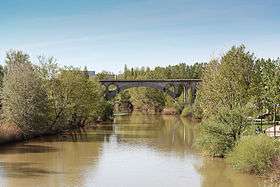Vega Sicilia

Bodegas Vega Sicilia is a Spanish winery located in the Ribera del Duero Denominacion de Origen in Valladolid, Castilla y León (North of Spain). The "Vega Sicilia" wine is well known as one of the most notable Spanish wines. The winery was founded in 1864 by Don Eloy Lecanda y Chaves, who planted various grapes from the Bordeaux wine region of France, including Cabernet Sauvignon and Merlot, which are still being used in the wines today.[1]
Since 1982, the same year that the Ribera del Duero was granted Denominación de Origen (DO) status, the winery has been owned by the Álvarez family who are members of the Primum Familiae Vini.[1]
In comparing the wines of Spain to the First Growth wines of Bordeaux, wine expert Hugh Johnson, after comparing Rioja producers Marqués de Riscal and Marqués de Murrieta to Château Lafite Rothschild and Château Mouton Rothschild, respectively, noted that "Vega Sicilia is the Latour; but Latour of a vintage that has raisined the grapes and fried the picking crews."—a reference to the significantly warmer climate and different growing conditions of the Ribera del Duero.[2]
Vega Sicilia's wines are recognised worldwide as some of the finest and most valued red wines on the market, with its top wine selling for an average of $388 per bottle.[3]
History

Vega Sicilia was founded by Eloy Lecanda y Chaves, a Spanish winemaker who was trained in the Bordeaux wine region of France. When he returned to his homeland of Castile, Don Eloy Lecanda brought with him several Bordeaux grape varieties.[4] In the 20th century, Vega Sicilia earned a reputation as being one of the most notable wine in Spain.[5]
Over its history, the winery has had many notable winemakers including Mariano García who was winemaker from 1966 to 1996 before moving on to produce his own labels. Today, the current winemaker is Xavier Ausás.[1]
Name

The name Vega Sicilia has appeared in Spanish documents that existed several centuries before the winery was founded though the exact origin of the name is currently unknown. Despite the similarities of the name, Vega Sicilia has no connection to the island of Sicily of the Italian wines of that region. The word Vega refers to the green vegetation that grows along the riverbank of the Duero while Sicilia refers to Saint Cecilia, the patron saint of musicians, after whom several villages in Castile and León is named after. The winery's founder Don Eloy Lecanda y Chaves left no known written records on why he chose Vega Sicilia as his winery's name.[4]
Vineyards
When Don Eloy Lecanda y Chaves first planted the vineyards of Vega Sicilia he included Cabernet Sauvignon, Merlot, Tempranillo and Malbec in his plantings. The extensive use of Bordeaux varieties was unusual in the Ribera del Duero at the time and though future plantings have focused more on Tempranillo, nearly 40% of Vega Sicilia's vineyards are still planted with traditional Bordeaux varieties including nearly 25% planted to Cabernet Sauvignon alone.[5]
Many of Vega Sicilia's 250 acres are planted with old vines, some more than 100 years old, and thus usually produce a very low yield during harvest. In fact, many of the plantings that go into the flagship Unico wines are often harvested at less than one ton per acre.[4]
Wines
Vega Sicilia is noted for its patience in winemaking and willingness to hold onto their inventory and age their wines in the barrel and bottle for many years until it fits the style that the producers are looking for. Depending on the vintage, the wine could be held by Vega Sicilia for decades until it is released. For example, in 1991 the winery released both the 1968 and 1982 vintages after 23 and 9 years aging.[4]
Vega Sicilia produces three different types of wine.[1]
- Unico - This Gran Reserva wine is the signature wine of Vega Sicilia that is usually released 10 years after vintage though some bottlings may not be released for up to 15 years or even longer. Taken from some of the oldest vines in the Ribera del Duero, the wine is mostly Tempranillo (approximately 80% but depending on vintage) and Cabernet Sauvignon (approximately 20%). In an average vintage, Unico will account for a little less than a third of Vega Sicilia's production.[5] Though in poor vintages, the winery may not produce any Unico.[4]
- Valbuena 5° - The 5° indicates that this wine has been aged for five years prior to release. The wine is composed mostly of Tempranillo, with Merlot and Cabernet Sauvignon.
- Vega Sicilia Unico Reserva Especial - A non-vintage blend of different Unicos, aged at least for 10 years. This wine can include grapes from vintages harvested more than 30 years apart and usually only available to private customers under strict allocation.[4]
Other wines
Until 1998, Vega Sicilia also produced a Valbuena 3° (indicating three years of aging prior to release), although this wine has since been removed from the market.
In 1991, the Alvarez family established Alión winery next door to Vega Sicilia with the aim of producing more modern style Tinto Fino red wines that are aged in new French oak barrels. In 1997, they established the Pintía winery in the nearby Toro wine region.[1]
References
- 1 2 3 4 5 J. Gordon (ed) Opus Vino pg 215, DK Publishing New York 2010, ISBN 978-0-7566-6751-1
- ↑ H. Johnson Vintage: The Story of Wine pg 429-432 Simon and Schuster 1989 ISBN 0-671-68702-6
- ↑ "Vega Sicilia Unico Gran Reserva, Ribera del Duero, Spain: prices". Wine Searcher. Retrieved 2016-11-23.
- 1 2 3 4 5 6 K. MacNeil The Wine Bible pg 430-435 Workman Publishing 2001 ISBN 1-56305-434-5
- 1 2 3 A. Bespaloff Complete Guide to Wine pg 174-175 Penguin Books 1994 ISBN 0-451-18169-7
External links
- Profile of Vega Sicilia by the Wine Doctor
- Profile of Vega Sicilia
- Vega Sicilia website
- Vega Sicilia inside
- 150th Anniversary of Vega Sicilia
- Vega Sicilia, Tempos brand
- Wine Harvest at Vega Sicilia